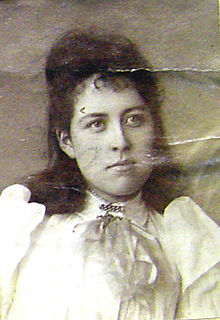Catherine Wolfe Bruce

Catherine Wolfe Bruce (born January 22, 1816 in New York City , † March 13, 1900 in New York City) was an American philanthropist and promoter of astronomy .
Life
Catherine Wolfe Bruce was the daughter of George Bruce (* July 5, 1781 , † July 6, 1866 ) and Catherine Wolfe. Her father had made his fortune as a designer and font maker. She was privately tutored and went on extensive educational trips to Europe. She spoke several languages, including Latin. She translated the hymn Dies Irae attributed to Tommaso da Celano into English and published it in 1890 as a private print. She remained single and lived on her inherited wealth. In 1887, in memory of her father, she set up the George Bruce Free Library in New York , which is now part of the New York Public Library.
Although she had a lifelong interest in celestial events, it was only at the age of 73 that she came into closer contact with astronomy. In a popular science article in Sidereal Messenger in 1888 , Simon Newcomb claimed that the essential discoveries had already been made. She reached out to astronomer and telescope builder Alvan Graham Clark to find out how she could support further research. In 1889 he introduced her to Edward Charles Pickering , who wanted to photograph the whole sky and built an outstation of the Harvard College Observatory in Arequipa , Peru . She donated $ 50,000 for a 24-inch telescope for this Boyden Station . This Bruce telescope was moved with the station to the Boyden Observatory in Bloemfontein , South Africa , in 1927, as better weather conditions were expected there. One of the most important discoveries with this telescope is the period-luminosity relationship by Henrietta Swan Leavitt .
She supported astronomy between 1889 and 1899 by donating more than $ 175,000 towards the purchase of several high-performance telescopes , including for the Harvard College Observatory , the 10-inch Catherine Bruce astrograph at the Yerkes Observatory based on the concept of Edward Barnard (see Barnard Catalog ), and for Max Wolf the Bruce double astrograph of the State Observatory Heidelberg-Königstuhl . She also provided Pickering with a $ 6,000 grant to support projects in the United States and Europe. I.a. Simon Newcomb received money for his new planetary tables ( ephemeris ), which served as the basis for the ephemeris . Johann Georg Hagen was able to publish the Atlas Stellarum Variabilium thanks to a deficiency guarantee. Thanks to a donation of $ 1,000, Ladislaus Weinek was able to publish the Prague Photographic Moon Atlas .
The Bruce Medal of the Astronomical Society of the Pacific, as an award for special astronomical achievements, was donated by her.
The asteroid (323) Brucia and the lunar crater Bruce were named in her memory . The asteroid Brucia was first discovered by Max Wolf using the photographic method in 1891 . For her support she was awarded a gold medal by the Grand Duke of Baden.
Works
- Catherine Wolfe Bruce: Dies Irae , New York, 1890
- Johann G. Hagen, Catherine Wolfe Bruce, Michael Esch, Friedrich Becker, Frances Woodworth Wright, Johan Willem Jakob Anton Stein: Atlas stellarum variabilium I -IX , Specola vaticana, 1941
proof
- S. Newcomb: Prof. Newcomb's new planetary tables , In: The Observatory 18 (1895) 86, bibcode : 1895Obs .... 18 ... 86N
- Obituary Notices: Associates: - Pickering, Edward Charles , Monthly Notices of the Royal Astronomical Society 80 (1920) 360
- HB Kaster: Note Regarding the Death of Miss Catherine Wolfe Bruce and Her Services to Astronomy , Publications of the Astronomical Society of the Pacific Vol. 39, No. 231 (1927) p. 315
- MB Ogilvie and JD Harvey: Biographical Dictionary of Women in Science , 2000, ISBN 0-415-92040-X
Web links
| personal data | |
|---|---|
| SURNAME | Bruce, Catherine Wolfe |
| BRIEF DESCRIPTION | American patroness of astronomy |
| DATE OF BIRTH | January 22, 1816 |
| PLACE OF BIRTH | New York City |
| DATE OF DEATH | March 13, 1900 |
| Place of death | New York City |

